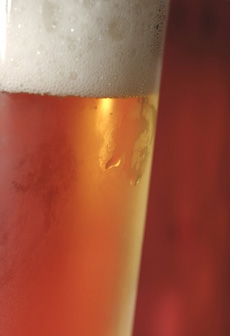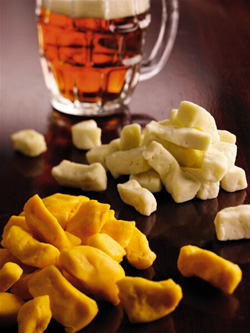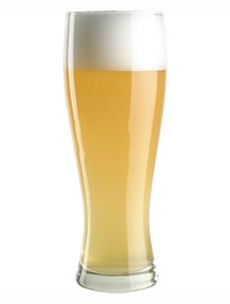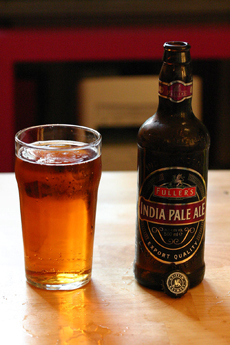Beer Glossary: A Glossary Of The Different Beer TypesPage 2: Types Of Beer Terms & Definitions for the terms with the letter B This is Page 2 of an 8-page article. Click on the red links below to visit other pages. This glossary is protected by copyright and cannot be reproduced in whole or part. You are welcome to link to it. Note that there are many hundreds of official beer styles. To see the full list, visit The Brewers Association.
|
 If you don’t know a bitter from a hop, use this glossary as a quick study guide. After you pass the test, treat yourself to an ale or a lager. Photo by Odelia | CSP. |
|
| BARLEY WINE or BARLEYWINE An English term for an extra-strong ale, implied to be as potent as wine (beers tend to be 3% to 5% alcohol, compared to 10% to 15% for wines).
|
||
| BAVARIAN BEER and BOHEMIAN BEER Bavarian and Bohemian both describe the region the beer comes from, not a particular brewing style. Although a brewer might be located in Bavaria or Bohemia, you’d still be ordering a weissbier, a lager, a dark ale, etc. (i.e., a particular style of beer based on seasonality and personal preference). Appending the region is marketing cachet, evoking an area famous for its good breweries. It’s no different from appending the entire country name on exports: “German beer” or “Czechoslovakian beer,” for example, since both countries are known for making fine beer. Bohemia, in the Czech Republic, is known for its Pilsner beers (named after the city of Pilsen, Czechoslovakia). Bavaria, in southern Germany, is known for its lagers.
|
||
| BEER or BIER One of the oldest of alcoholic beverages, with archaeological evidence dating to about 3000 B.C.E., beer was well known to the ancient Egyptians, who were good home-brewers. In fact, for much of its history, beer was a home brew or of monastery manufacture. Not until late Medieval times did it become a commercial product; it is now made by large-scale manufacturers in almost every industrialized country (though today’s beers are lower in alcohol content than their predecessors). Beer is made by brewing and fermenting cereals (today malted barley is most commonly used), usually with the addition of hops as both a flavoring agent and stabilizer). The word beer comes from Middle English ber, from Old English beor, and probably from Latin bibere, to drink. Bier is the modern German word for beer. |
 An all-American snack: beer and cheese curds. Photo courtesy of Wisconsin Milk Marketing Board. Read more about cheese curds, a Wisconsin specialty, including a recipe for fried cheese curds—great with beer! |
|
| BEER-MAKING PROCESS Beer is fermented grain. American beer is made of barley, except as noted; for example, wheat beer, which is mostly produced by craft brewers. The barley is malted (soaked in water until it is partially germinated, then dried), which releases the starches, which in turn are made into fermentable sugar. It is the fermentable sugars that are converted into beer. To begin the process, ground malt is added to a mash tun, where it is mixed with boiled, pulverized corn (grits) to create the mash. The hot grits raise the temperature of the mash, releasing enzymes that break down the starches into fermentable sugars. The mash is then separated from the fermentable sugars, which are called the wort. The wort is boiled for 90 minutes or so, then hops are added. Then the wort goes into the fermentation tank, where carbon dioxide is created and the wort transforms into beer. It is cooled, aged and bottled.
|
||
| BELGIAN BEER Each country is known for particular types of beer. Belgian beer styles include dubbel, enkel, Flanders red ale, lambic, oud bruin, saison, tripel and witbier. Brewery Ommegang makes a hoppy, Belgian-style pale ale, or BPA.
|
||
| BERLINER WEISSE A classic Berlin brew, a white, top-fermenting wheat beer that has gone through lactic fermentation to produce a sparkling high carbonation, a low alcohol content (around 3% by volume) and a characteristic sour flavor.
|
||
| BIÈRE BLANCHE French for white beer, bière blanche is a wheat beer, the same as a Belgian witbier. See Weisse.
|
||
| BIÈRE DE GARDE French for "œkeeping beer," this is a pale ale traditionally brewed in the Nord-Pas-de-Calais region of France. Like a saison, it was a farmhouse beer brewed in the winter and spring for summer consumption. It was "œkept" to avoid performance problems inherent with brewing with the yeast in the hot weather.
|
 Bière blanche, French for white beer. The light-to-medium golden color is common to wheat beers. Photo courtesy Rolling-Beers.fr. |
|
| BITTERS or ENGLISH BITTERS A well-hopped beer, mostly found in a draught (pronounced draft) beer. The name suggests hop bitterness. There is often some acidity in the finish; the color varies from bronze to deep copper.
|
||
| BLONDE BOCK A medium-hopped beer with a rich, malty flavor. Bock beers (see next entry) were originally brewed by monks to minimize hunger pangs during fasting periods. Most bock beers are dark in color. Today, brewers make them in a golden style, known as “blonde” bocks.
|
||
| BLONDE ALE or GOLDEN ALE An invention of the American craft beer movement, Blonde Ale is alight golden ale with a light to medium body and moderate bitterness and maltiness. It was created to help drinkers of mass-market American beers to transition to craft beers.
|
||
| BOCK or BOCKBIER Bock is the German word for strong, referring to a strong beer brewed from barley malt. It is a dark sweet, heavy beer, similar to the Munchener beers, but stronger. A true bock style beer has a foam collar “thick enough to steady a pencil.” Originally used to celebrate the end of the brewing season, Bock beer is traditionally served in autumn, late winter and spring. It was originally brewed by top fermentation in the Hanseatic League* town of Einbeck (beck bier became bock bier) in Lower Saxony, where it is still brewed (and known as Ur-Bock, the original bock). But the style has evolved. Bock was once a heavy, dark beer brewed in winter for consumption in spring. German bock beers are now brewed by bottom fermentation and are usually dark brown. Pale bocks are increasing in popularity and a distinction is sometimes made between light bock beer and dark bock beer. Because the word bock also means billy goat in German, a goat is often found on the labels of bockbier brands. Pair it with big flavors: game, roasted meats, strong cheeses (aged Cheddar, Emmenthaler, Gruyère), creamy semi-soft cheeses with an earthy, buttery flavor, smoked cheese and Bockwurst sausage (or other veal or veal-and-pork sausages). See also double bock and triple bock. *The Hanseatic League was an economic alliance of trading cities and their merchant guilds in Northern Europe during the 13th through 17th centuries. It was created to protect commercial interests and privileges.
|
 Bockbier with smoked Gouda cheese. Photo courtesy of Wisconsin Milk Marketing Board. |
|
| BOHEMIAN BEER See Bavarian beer
|
||
| BOTTLE CONDITIONING
Bottle conditioning is the practice of allowing the beer to ferment a second time in the bottle. This produces more alcohol and carbon dioxide, which preserve the freshness of the beer. The technique also produces complex, flowery flavors. They are naturally fizzy from the carbon dioxide. Ales"”top fermented beers"”are usually the styles that are bottle conditioned. The process leaves yeast sediment at the bottom of the bottle. Some styles (for example, Belgian Wit biers and Weissbiers swirl the sediment into suspension to avoid the bottom sediment. Bottle conditioned beers have more character than filtered, carbonated beers. Like wine, they can mature and develop over years in the bottle.
|
 Fuller’s India Pale Ale (IPS) is an example of a bottle-conditioned beer. Photo courtesy Wikimedia. |
|
| BRAGGOT Braggot is a Medieval brew that dates to 12th century in Ireland. In the late 1300s, it was mentioned in Chaucer’s Canterbury Tales. It is made by blending mead and beer along with spices and herbs, to produce a strong drink with uncommon flavors.
|
||
| BREWING In the brewing processes, a mash, generally prepared from crushed barley and water (and often using other cereals such as rice and corn) is heated and rotated in a mash tun. This dissolves the solids and permits the malt enzymes to convert the starch into sugar. The solution, called wort, is drained into a copper vessel, where it is boiled with the hops which provide beer with its bitter flavor. The liquid is then run off for cooling and settling and is transferred to fermenting vessels where yeast is added. The yeast then go to work converting the sugar into alcohol. Unlike fermented beverages such as wine, which continue to evolve and improve in the bottle (“bottle age”), brewed alcohols like beer and saké are meant to be drunk fresh. After a few months, they will begin to deteriorate.
|
||
| BREWPUB A microbrewery that does not produce to distribute its beers, but sells them primarily through its own restaurant or bar, which is generally on the premises of the brewery.
|
||
| BROWN ALE
A dark brown ale made with a dark or brown malt; the roasted malt produces caramel and chocolate flavors. The original style originated in London but today brewed in a variety of styles: sweet, low alcohol beers (in southern England, such as Mann’s Original Brown Ale), medium-alcohol amber beers with moderate bitterness (such as Newcastle Brown Ale and Samuel Smith’s Nut Brown Ale) and malty/hoppy American beers which were traditionally drier due to the American hops (Brooklyn Brown Ale, Pete’s Wicked Ale, Sierra Nevada Brown Ale). However, with more American brewers using imported hops, this may change.
|
 Brown ale and mozzarella skewers. Photo courtesy of Wisconsin Milk Marketing Board. |
|
|
Continue To Page 3: Terms Beginning With C
|
||
Last Updated Apr 2018
© Copyright 2005-2025 Lifestyle Direct, Inc. All rights reserved. All images are copyrighted to their respective owners.